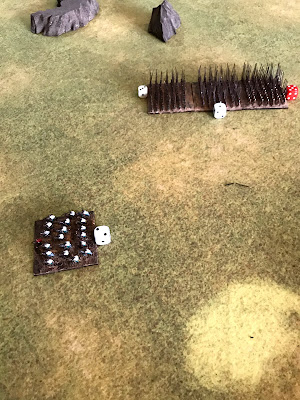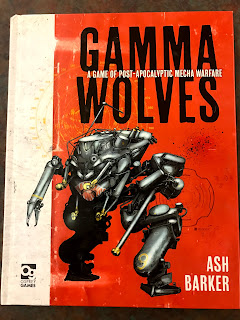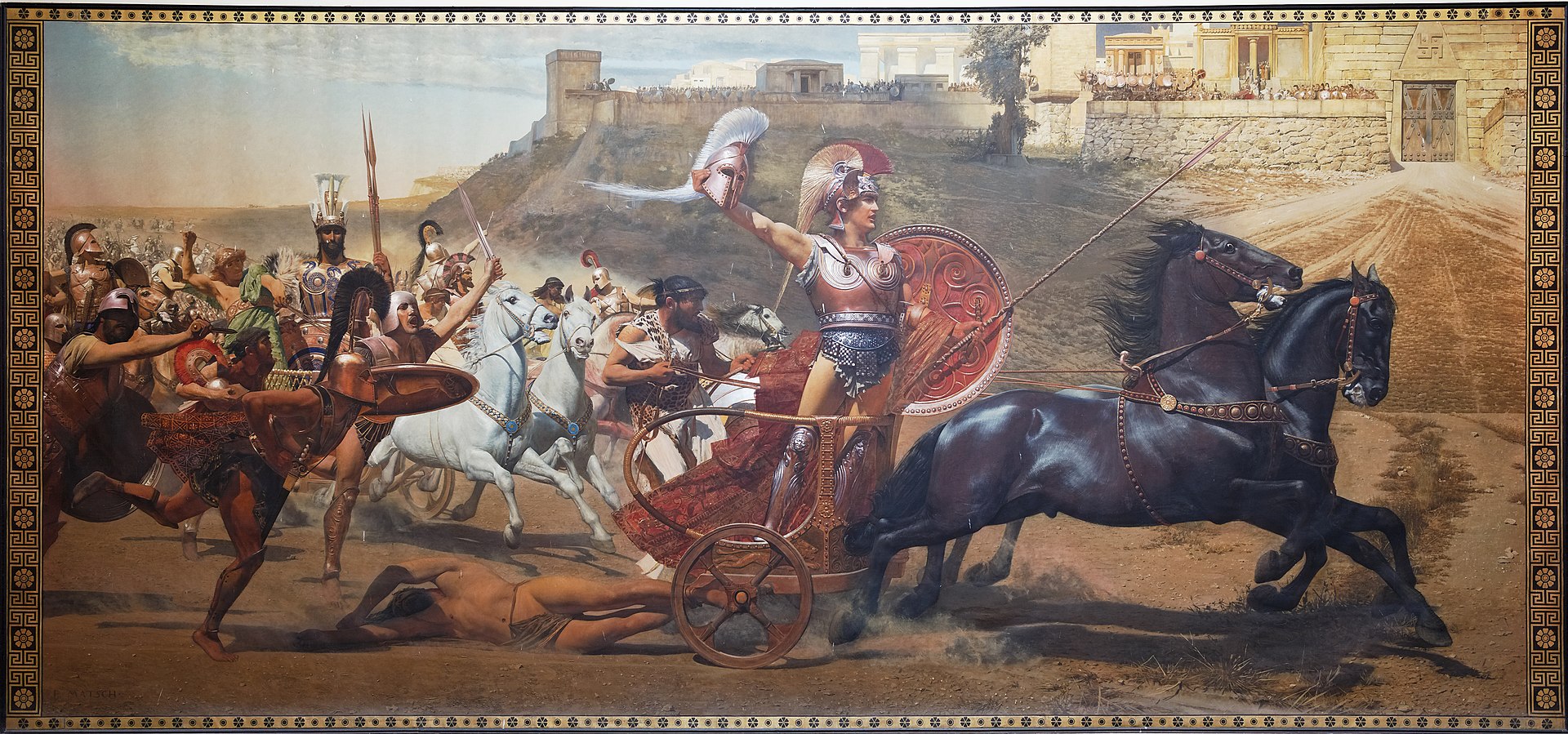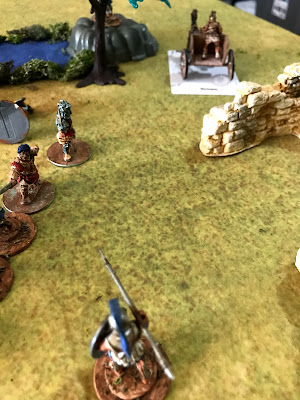. The game is a model vs model skirmish game to represent heroic retinue's fighting against each other in Homeric -inspired combat. As such, the heroes are the main focus with a retinue of soldiers attracted by their fame.
The hero Adonis and his faithful friend Butes and their retinue have been traveling, looking for adventure near the Bospherus. After a long days march, they grew weary. With the aid of a young woman they met travelling, they were directed to a nearby spring to refresh themselves. Little did they know that this young woman was, in fact, the nymph who inhabited the spring who had been smitten by Adonis' good looks.
As Adonis and his men bathed and refreshed themselves they were approached by another band of warriors. They were led by Diomedes and his fellow Euryalus and his band. They had followed the flight path of an owl and arrived at the same spring. They too were thirsty and tired from a long journey cross-country.
Diomedes as the favored of Athena demanded access to the spring. Adonis had heard of this fellow Diomedes, and knew he was no friend of his patron, Aphrodite. At first, he seemed to acquiesce to Diomedes demand. However, it was only a ruse to give him and his men enough space to arm themselves.
Adonis and his retinue soon returned. Diomedes and Euryalus had not yet stripped themselves of their war gear. Instead, they turned to face off against the interlopers who dared challenge them.
Forces:
In Homer's Heroes both sides always have 1 Hero, 1 Second, and then 8 soldiers of varying gear. Some can be traded in for a chariot as well. Then, each Hero also has a Patron Greek god or goddess that offers them special bonuses.
Adonis and his retinue have the following composition:
- Adonis- Hero
- Aphrodite
- Sneaky- The Hero can re-roll a single dice in an Opposed "Hide" test
- Armor, Shield, Hand Weapon
- Butes- Second
- 4 Soldiers
- 2 Soldiers
- 2 Soldiers
Diomedes of Thrace and his retinue looks like this:
- Diomedes- Hero
- Athena
- Glare- The hero can use a "glare" action to freeze an enemy in place with an opposed roll. The model loses any unused activations.
- Spear, Shield, Armor
- Euryales- Second
- Chariot
- Driver- Dagger
- Soldier- Spear, Shield
- 4 Soldiers
Mission
The game lasts until 1 retinue Runs Away, turn 8 ends, or 1 hour of play has elapsed. The retinue with the most models within 6 MU of the Spring at the end of the Disengagement turn is the winner.
1 MU = 1 inch in today' game
Set-up
Today's game will be played on a 36 x 36MU board.
The spring is set up in the center of the board. We divide the board into 4 sections and determine the following:
- Grove- Difficult, Hard
- Field- Soft
- Ruined building - Obstacles, Hard
- Open
Diomedes retinue is set up anywhere within 6 MU of the spring. Adonis is placed on any two adjoining board edges, he chose the south and west.
Turn 1:
Adonis and his warband have the most models, so they choose to activate a model first. One of his bow armed soldiers fires a shot at the Chariot. The driver of the chariot ducks aside as the arrow flies past.
Euryales goes next and moves from the ruined building to in between two of his closests soldiers. He does not want to be caught out by Adonis.
The second of Adonis' bow armed soldiers fires at the chariot but his arrow falls short.
The rest trade off moving towards the fight as Diomedes goes to his friend Eurylas' side. Adonis slips into the ruined building and hides.
The Chariots races forward and the soldier riding in it attacks one of Adonis' Javelin armed soldiers. His spear thrust catches the man in the leg, and he begins to fall back.
Turn 2:
Adonis still has more soldiers, so gets to go first.
Butes takes a mighty swing at the soldier he is facing with his two-handed weapon. The soldiers is downed by Butes, the favor of Aphrodite must be with him!
Diomedes charges into the nearby line of Adonis' spearmen and attacks ferociously, injuring the man's leg exposed below his shield. However, the soldier passes the Fear check and stays in the fight. Diomedes chooses to use Glare to avoid a counter-attack. He glowers at the lesser man. The man is frozen in fear! A fellow soldiers jumps into help the stricken man.
More soldiers jump into the combat swirling around Diomedes, both to help and attack.
Seeing his chance, Adonis leaps from cover and attacks Euryales. His sword is true, and Euryales is hit in the arm, but does not flee.
Adonis' bow and javelin armed soldiers move towards the spring. Meanwhile, a loan Diomedian soldier falls back to the spring to defend it.
Turn 3:
Adonis' retinue gets to activate first.
One of the soldiers fighting Diomedes activates and attacks with a soldier assisting him. Diomedes also has an assist. Diomedes manages to just fend off the thrusts with his shield. He decides to fight back. He pushes one of the soldiers back out of combat with his first attack. He then attacks the frozen one again. This time, his spear is true and he downs his foe! He uses his last activation to attack the last soldier he is facing. However, the soldier blocks with his spear.
Butes sprints for the spring, and uses his last activation to help Adonis in his fight with Euryales.
Two soldiers slug at each other with no effect. The chariot swings around and moves in on the fight between the two soldiers. The soldier in the chariot lashes out. Thankfully, the soldiers spear gives him a 360 combat arc and he is able to block the thrust.
The last Diomedian soldier falls back to the Spring as Adonis' Bow and Javelin armed troops spring towards it.
Adonis continues his attack on Euryales with Butes support. Despite the injury to his arm, Euryales puts up a stunning defense using his shield, armor, and spear in a masterclass of defense work. He bats away or deflects all of Adonis' attacks.
Turn 4:
Both sides have lost a model, but Adonis still has more. His retinue goes first.
The pushed back soldier rushes back into help his friend deal with Diomedes. Diomedes activates next to try and clear them all out. He injures the soldier's leg, but he does not run away. Diomedes injures the second soldiers leg as well. He also stands his ground. This time, he downs the initial soldier with a spear butt to the helmet! Clunk! Adonis' soldier and Diomedes soldier fail to do much other then make a lot of noise in the fight.
Adonis activates next against Euryales. This time, Adonis downs noble Euryales with a swing of his sword! He uses his next action to engage the soldier helping Diomedes. However, he fails as the soldier's spear whirls around him to protect himself.
Diomedes chariot rushes up, and the soldier attacks Adonis from the rear. The spear tip glances off the hero, and he makes a successful Fear test to avoid running away.
Butes rushes forward and attacks the soldier in the chariot, but the man is ready and blocks the attack with his shield.
A Diomedian soldier climbs to the spring to defend it. The bow armed soldiers of Adonis fire on this lone defender, but he knocks the arrows aside with his shield.
Turn 5:
Both sides have two men down. Adonis gets to go first.
Butes attacks the Chariot once more. Butes manages to hit the soldier hard enough with his two-handed weapon, that he is knocked from the chariot! However, he quickly springs to his feet and is ready to fight again. The chariot itself rumbles away.
The soldier helping Diomedes attacks the last of Adonis' soldier in their melee. To no effect. Adonis' soldier attacks back. The Adonis' soldier pushes Diomedes' fellow soldier back and out of the combat!
The soldier from the chariot charges forward and locks Adonis up into combat separate from Diomedes. Adonis attacks him for his impudence. It takes a flurry of sword thrusts and shield bashes, but eventually the soldier is taken down by Adonis.
Diomedes is also left alone with a single enemy soldier, and attacks with everything he has. However, Adonis' soldier manages to fend off the hero with his shield.
The Diomedian soldier on the spring sees the approaching Chariot and mounts up. The rest of Adonis' retinue sprint towards the spring.
Turn 6:
Adonis still has the initiative.
Butes charges into a Diomedian soldier, his two-handed weapon swinging. The soldier's shield catches the blow easily.
Diomedes tries to finish off the soldier he is fighting. However, he again fails to finish the man. Perhaps he should Glare at him next time?
This time, Adonis leaps into the fight with Diomedes. However, the Theban hero is ready and blocks the attacks.
The injured Javelin armed soldier clambers up onto the spring. The Chariot rumbles away. The archers fire arrows at it, but they stick useless into the car wall.
Turn 7:
Adonis still has more soldiers.
Adonis himself starts the turn battling with Diomedes. This time, Adonis slashes Diomedes spear arm. Then, a clever feint allows him to slash the Heroes leg as well.
The soldier fighting Butes attacks him. To no avail.
The Javelin armed soldier on the spring throws one at the Chariot, but also only sticks it into the side of the car.
Diomedes attacks the soldier fighting with Adonis first. The soldier deftly blocks again and whirls away from the heroes spear.... again!
Butes manages to injure the leg of the soldier he is fighting. However, he stays in the fight and passes his fear test.
Archers again miss the chariot. It rumbles up and the soldier inside spear outward with his weapon. The archer nimbly steps aside. The last Javelin armed soldier throws and misses.
Turn 8- Disengagement Turn
Both sides are growing very tired. Adonis' troops go first.
Butes attacks the soldier he is facing, but the man stumbles out of reach.
Diomedes attacks the soldier in his battle again. Again, with help from Adonis, he avoids any serious issues. However, his counter-attacks are also insufficient. Adonis continues the assault. Another arm injury reduces Diomedes further. He also gets another slash to the legs, but he is still standing.
The Chariot soldier strikes out at the archer, but misses. The chariot turns to try and pick-up their boss.
Meanwhile, Adonis' ranged soldiers rush to the springs and take up position on it.
Conclusion
Adonis and his retinue win as they have four soldiers standing on the Spring to Diomedes 0.
An omen from Olympus stops the fighting. An owl is startled from the trees near the spring and flies away. Diomedes and Adonis see this and immediately recognize it as a sign! Athena has signaled that Diomedes has lost the skirmish, and her favor has left the spring.
Adonis calls a halt to the fighting, as Diomedes does the same. The soldiers take a step back, and eye each other with hostility.
Diomedes grounds his spear haft into the ground. He leans on the weapon heavily, his wounds bleeding openly. "Your skill with your sword is a match for your handsome locks Adonis," Diomedes pants.
Adonis shakes the blood from his blade before sheathing it, "And you are a fearsome opponent. Come, take a moment to rest at the spring, drink up, and tend to your men's wounds. You and your men can leave before nightfall, and leave the Spring to us for the evening."
"You are indeed a hero worthy of Aphrodite."
Adonis narrowed his eyes at the wounded Theban, and decided to take his words with sincerity, "You are too kind. Come let us help our comrades!"
I finally got Homer's Heroes on the table, after having the draft rules done for about a year now. That gives you an idea of the game design process and what the pipeline looks like. When I finished writing the game, I even had minis painted I could use with it! I have been too busy getting the finishing touches on
Wars of the Republic and
Castles in the Sky for Osprey to do much else.
When I wrote Homer's Heroes I had a few goals in mind:
Differentiate between Heroes, Seconds, and Soldiers
Weapons and Armor matters
Model vs Model skirmish
Scale and Model Agnostic
Homeric Greek Veneer
Simple and Quick Gameplay
Well, did I do it? Maybe?
Heroes and Seconds get to use more dice then Soldiers, therefore increasing their chances to "do" something. In addition, they get a matching number of activations. In theory, a Hero should make short work of a Soldier. In this game, we saw Diomedes take on a group of soldiers and survive; but he could not finish off the last one! Why? Because a group of soldiers adds dice to their own pool allowing them to be the equal of a hero if they are supported! In addition, Seconds and Heroes were the ones most reliable in taking out opponents. Heroes and Seconds are also able to land more than 1 potential hit that can escalate damage to Downed or Unconscious and Possibly Dead much faster.
Weapons and Armor matter.... did they? Yes for the most part weapons and armor played a big part in the battle. Diomedes and most of his crew were using Spears. This gave them a 360 degree combat arc which they used to good effect when they got bushwacked by multiple soldiers or Adonis himself in the side/rear outside of their normal combat arc. However, their shields were not useful outside of the combat arc. Therefore, melee placement mattered and a model could maximize/minimize attack and defense benefits from good placement. We also saw that the extra dice from Butes two-handed weapon was useful to finish off foes with more potential hits giving him the chance to down foes rather than injure them.
As for a Homeric veneer, I can add more of that when I bolt on the campaign system. However, for initial flavor we do have Heroes doing most of the work of killing. However, it was the soldiers who actually won the game for Adonis. Close combat is more important than missile weapons which is also a Homeric idea. Finally, duels between Heroes and Seconds carried the majority of the action today. Plus, there was that fun chariot racing around and that was pretty Homeric. Perhaps it is too early to tell, but it seems like the Homeric veneer is there and ready to be reinforced via campaign elements. We did use the Favor of the Gods for both Heroes, even though I think Diomedes should have tried his a few more times.
Simple and Quick Gameplay? Well, I did uncover a few places where the rules needed some tweaking. It is unclear that this is an alternate activation game. There are also some ambiguities around when a rival retinue should try to run away or withdraw. The winner of the Melee gets a lot of choices to push people back, pin them, rotate facing, break-off, etc. However, you have to win the Melee before you can do those things and most of the time it was just better to try and deal damage. The same can be said with shooting. Once you get into hand-to-hand, it can become a bit of a game of Yahtze, but I am unsure how to approach this yet as there are a lot of simple nuances that add tactical depths to Melee such as support attacks, combat arcs, pushing foes around the board, etc. but in the heat of the moment it just seems to come down to a dice roll-off. However, game play was quick with a surprising amount of nuance for such a simple and easy to play game.
Scale and Model agnostic is a yes. I use my standard bag of tricks that I have been applying to all my games lately for that.
Overall, not bad for a WIP set of rules. There are some pieces to be clarified and re-written, and I still have not cracked the code completely on Melee yet. I think adding campaign elements and some scenarios will really cement the Homeric veneer too. More work to be done on this one before it is ready for publishing though.
Become a Patron and get access to all the cool stuff, a peak behind the curtain of Blood and Spectacles, and early-access to playtest games!
Check out the latest publications and contact me at our
Blood and Spectacles website










































